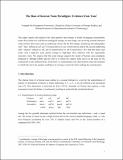The base of Korean noun paradigms: Evidence from tone
Author(s)
Do, Youngah; Ito, Chiyuki; Kenstowicz, Michael
Downloadbase_korean_noun_paradigms.pdf (1.445Mb)
OPEN_ACCESS_POLICY
Open Access Policy
Creative Commons Attribution-Noncommercial-Share Alike
Terms of use
Metadata
Show full item recordAbstract
This paper reports and analyzes the tonal patterns that emerge in South Kyengsang monosyllabic nouns that exhibit two well-known analogical changes in stem shape, one involving coronal obstruent codas and the other stems with an underlying cluster. By the first change, underlying and orthographic /nach/ ‘face’ inflects as nat̚, nach-ɨl (conservative) or nas-ɨl (innovative); and by the second underlying /talk/ ‘chicken’ inflects as tak̚, talk-ɨl (conservative) or tak-ɨl (innovative). We find that many such nouns with a high-low tonal pattern change to high-high when inflected with the segmentally innovative stem. We propose that this tonal change supports the model of Korean noun paradigms proposed in Albright (2008) and Do (2013) in which the citation form serves as the base for the construction of the suffixed forms. If the base is a neutralization site, then learners select the alternant in which they have the greatest confidence of scoring a correct hit when undoing the neutralization.
Date issued
2014-07Department
Massachusetts Institute of Technology. Department of Linguistics and PhilosophyJournal
Korean Linguistics
Publisher
John Benjamins Publishing Company
Citation
Do, Youngah, Chiyuki Ito, and Michael Kenstowicz. “The Base of Korean Noun Paradigms: Evidence from Tone.” Korean Linguistics 16, no. 2 (2014): 111–143.
Version: Author's final manuscript
ISSN
0257-3784
2212-9731